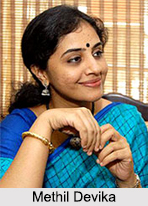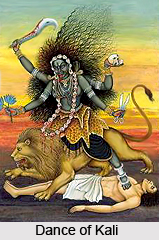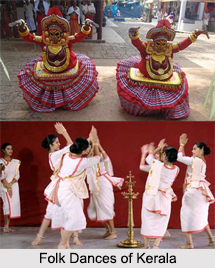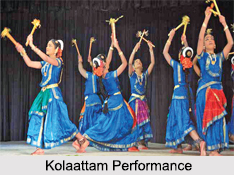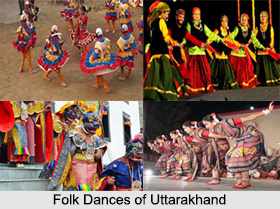 Folk Dances of North India is bathed by the regional freshness of the North. When it comes to the North Indian States, the folk dance, folk culture is in sync with the idyllic reservoir of the pulsating, brimming life of the mass. Dance becomes the language of the soul amidst the mountain dwellers and the valley populace. Folk Dance of North India projects the solidarity of the common mass in short.
Folk Dances of North India is bathed by the regional freshness of the North. When it comes to the North Indian States, the folk dance, folk culture is in sync with the idyllic reservoir of the pulsating, brimming life of the mass. Dance becomes the language of the soul amidst the mountain dwellers and the valley populace. Folk Dance of North India projects the solidarity of the common mass in short.
Folk Dances of Uttarakhand
Folk dance of Uttarakhand has a faraway reflection of the mountain vegetation. Uttarakhand has a wonderful cultural and traditional heritage confined within the folk dances.
Jhumeila Dance: This folk dance is performed in all major festivals like Baisakhi, Guru Purnima, and Sankranti. Jhumeila dance represents and praises the beauty of the Himalayan foothills.
Chaufula Dance: Chaufula is a spinning dance performed by all sections of the community, at night, in groups by men and women. These folk songs are composed for appreciating the gift of nature.
Hurka Baul Dance: Hurka Baul dance is performed during the cultivation of paddy and maize. The dance is named after Hurka, a drum used for musical accompaniment and Baul is the song.
Pandava Nritya: Pandava Nritya tells the tale of five heroes of Hindu mythology, the Pandava brothers of Mahabharata. It is performed for 10 to 12 days.
Bhotia Dance: Bhotias are an ancient tribe of Uttarakhand, and the namesake dance is performed as part of death rituals. By performing this dance, the soul of the dead is believed to be liberated.
Cholia Dance: Choliya dance is the sword dance, meant to depict the martial art traditions of the Kumaoni tribe. This dance form is thousand years old and is performed during local Rajput weddings.
Jhora Dance: Jhora dance is a spring time celebration performed by the local people by moving around in circles. It is a highly popular dance in the Kumaon Himalayas.
Mukhota Dance: Mukhota Dance is performed at a fair that starts from Vaishakha Sankranti in praise of Bhumiyal Devta.
Folk Dances of Kashmir
Kashmir also has its own share of festivities and glamour, when it comes to practicing the folk dances. Here are the popular folk dances from the "heaven on earth"
Dumhal Dance: Dumhal Dance is a famous folk dance of the Kashmiri people performed by only the men folk of Wattal, wearing long colourful robes and tall conical caps.
Kud Dance: Kud Dance is a typical community dance, performed in the middle mountain ranges of the Jammu region. Kud dance is performed during the rainy seasons and it exhibits swaying and sinuous movements.
Phag Dance: This dance form is performed by the farmers in the month of Phalgun. Both men and women can perform this dance. It is popular in both Kashmir and Haryana.
Chhathi Dance: Chhathi dance is a ritualistic dance, performed at the birth of new child. But, this dance is performed only on the sixth day of birth of a male child.
Rouf: One of the most popular traditional dances of Kashmir is Rouf. This beautiful dance form graces all occasions, especially Id and Ramzan days.
Hafiza Dance: Hafiza Dance is genrally performed at wedding ceremonies.
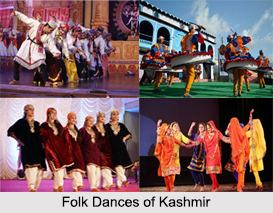 Bhand Jashan: Bhand Jashan is performed by a group of 10 to 15 artists in their traditional style, along with some light music.
Bhand Jashan: Bhand Jashan is performed by a group of 10 to 15 artists in their traditional style, along with some light music.
Bacha Nagma: Young boys of Kashmir perform Bacha Nagma dance, particularly during the harvest season. One of the young boys dresses up as a female dancer, performing Hafiza style of movements.
Wuegi-Nachun: A less popular dance is Wuegi-nachun. It is performed after the marriage ceremony, when the bride has left for her new home.
Folk Dances of Himachal Pradesh
Folk dances of Himachal Pradesh draw a high influence from mythological epics of Mahabharata and Ramayana. The folk music also displays identity and tribal culture of the people.
Dangi: It is one of the oldest folk dances of Himachal involving mainly female dancers. It is performed during the harvest seasons inside the temple of Goddess Naina Devi.
Chhanak Chham: It is performed as a tribute in the memory of the divine Lord Buddha. The lahaul is a region in spiti valley where the lamas perform the devotional dance for the occasion of Chakar.
Namagen: The autumnal hue is celebrated with Namagen dance. Drum plays an important part in this dance performance.
Losar Shona Chuksam Dance: Losar Shona Chuksam is an agricultural festival dance performance. Losar is the New Year of Tibetan people and it is performed by Kinnauris in their typical style.
Nati: This dance has various forms which vary from region to region. The popular ones include the Kinnauri Nati, Gaddi Nati, Kullu Nati, Shimla Nati and etc.
Dandras Dance: It is performed by the tribes of nomadic shepherd of Gaddi residing in Bharmaur of Chamba district.
Thoda Dance: It is a war dance which is performed before the men head out for war. It is ritualitically performed by holding an arrow and bow in hands.
Mala Dance: In this dance form, the dancers weave their arms together forming a pattern resembling beads on woven garland. They drink rice brew before performance.
Demon Dance: This dance form originated from Kinnaur and is performed with demon masks during the festivals of Bishu and Chaitol.
Dalshone and Cholamba Dances: These dance forms originated from the Ropa valley.
Folk Dances of Ladakh
Folk Dances of Ladakh are performed on different occasion including of Birthday celebration, flowering period, marriage ceremony, Ladakh festival, harvesting period, and more.
Jabro Dance: Jabro is a cultural dance of the nomadic people of Tibetan origin residing in Changtheng during Losar events.
Cham Dance: This is a cultural mask dance which illustrates the old happenings from the life of the 9th-century Nyingmapa educator Padmasambhava.
Dances of the Lamas: It is performed by Lamas and monks in the abbeys. The performance also include lots of Tantrik elements.
Bacha Nagma Dance: Bacha Nagma costume has a resemblance with Kathak gown. It is a team dance with one diva.
Folk Dances in Rajasthan
Rajasthan has many forms of folk dances which are attractive, skillful and enjoyable. . Folk music is a vital part of these dances.
Ghoomar: Ghoomar from Udaipur was ranked 4th in the list of "Top 10 local dances around the world†in 2013. Newly married bride is expected to dance ghoomar on being welcomed to her new marital home.
Kalbelia: Kalbelia dance of Jaisalmer is performed by a tribe of the same name. The dance made to UNESCO`s representative list of Intangible Cultural Heritage of Humanity in 2010.
Terah Taali: Terah Taali practiced by Pokhran and Deedwana, to honour their folk hero, Baba Ramdeo.
Gair Dance: Gair is a popular Rajasthani folk dance performed as a series of half swirl, as a simplier version.
 Chari Dance: In Chari dance, women hold chari or pots on their head and a lighted lamp is then placed in it. It belongs to Gujjar community of Kishangarh.
Chari Dance: In Chari dance, women hold chari or pots on their head and a lighted lamp is then placed in it. It belongs to Gujjar community of Kishangarh.
Folk Dances of Punjab
Punjab is considered the motherland of dances. The exuberance and vitality of the people are displayed in their folk dances.
Bhangra: Bhangra season starts with wheat sowing and then every full moon attracts teams of young men in every village who dance for hours in open fields.
Jhummar: Jhummar is a dance of ecstasy. It is a living testimony of the happiness of men during Melas, weddings and other major celebrations.
Luddi: This is a male dance to celebrate a victory. It is performed with drummer in the center.
Jalli: It is a religious dance associated with Pirs and recluses and is generally danced in their hermitages (khangahs).
Dhankara: At least two persons are required to perform this dance. Like other male dances it is danced in circles. It is also called gatka dance (dance of the dum swords).
Dhumall: This is a male dance performed in a circle. Drum is used as the accompanying instrument.
Teeyan: Giddha can be seen at its best when "Teeyan" or the women"s dance festival is celebrated. The dance takes place on the bank of a river or pond under big shady trees.
Folk Dances of Uttar Pradesh
Blessed with cultural richness, Uttar Pradesh has grabbed the attention with its popular folk dance and music.
Charkula Dance: Charkula Dance is popular in Braj during Holi where a veiled woman performs with 108 oil lamps on her head placed on a wooden platform. It is performed in praise of Lord Krishna.
Folk Dances of Haryana
Haryana is the land of folk dances, folk music and fairs. Folk dances of Haryana represent the culture of this state.
Khjoria Dance: Khjoria dance is a collective form of Jhumar dance style, performed by women from the central region of Haryana.
Loor Dance: Loor is a popular folk dance of Haryana is performed around Holi festival in the Bangar and Bagar regions.
Daph dance: Daph dance is a seasonal dance connected with the harvest and spring. It depicts the joyful emotions of the farmers.
Gugga dance: It is performed in praise of Gugga, a Chauhan Rajput. Five Bhagats are the Main dancers who carry their musical instruments including Dholak, Manjiras, Deru, Chimta and Cymbals.
Khoria Dance: Khoria dance is a variant of the Jhumar dance and is exclusively performed by women wearing gold-work skirts and colourful chunries.
Gangor Puja Dance: Gangor Puja dance is usually performed in Phalgun and Chaitra and is dedicated to Iswar (Lord Shiva) and Gangor (Goddess Parvati).
India is a land of many folk dances. Each has a style deeply influenced by tradition and heritage. Every region has its own folk dance with a purpose that is unique. Mostly performed in groups, it is a platform for bringing together people of a region on occasions that matter to each other.
